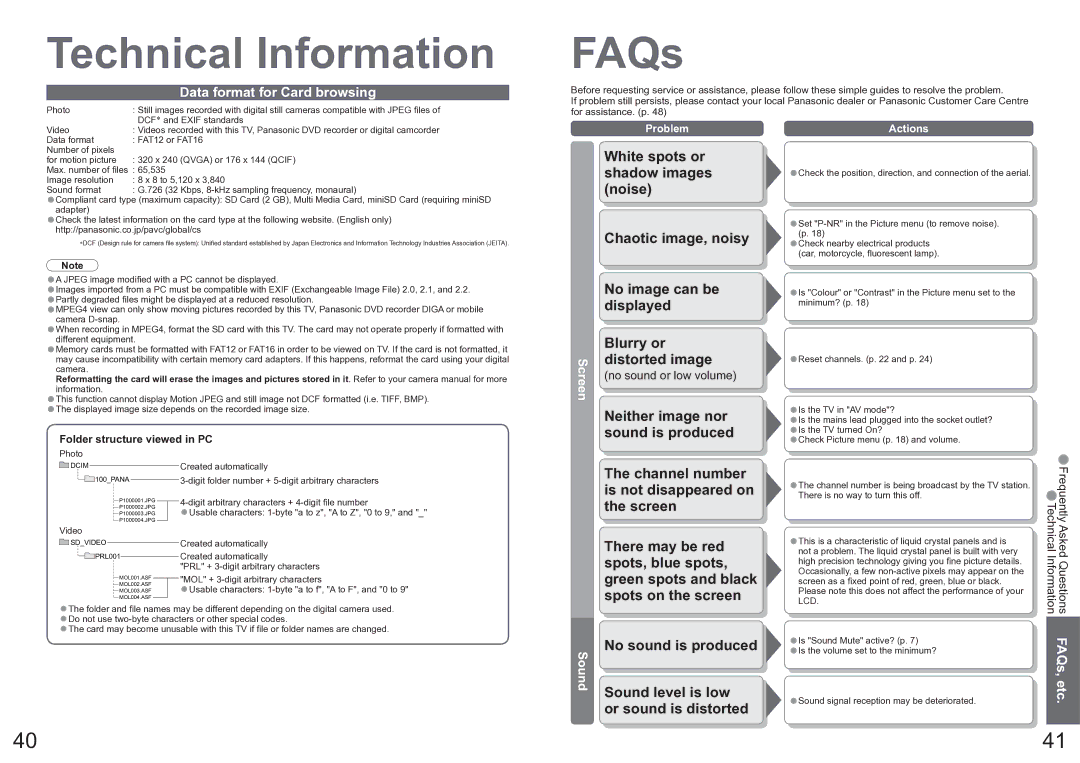
Technical Information
| Data format for Card browsing |
Photo | : Still images recorded with digital still cameras compatible with JPEG files of |
| DCF∗ and EXIF standards |
Video | : Videos recorded with this TV, Panasonic DVD recorder or digital camcorder |
Data format | : FAT12 or FAT16 |
FAQs
Before requesting service or assistance, please follow these simple guides to resolve the problem.
If problem still persists, please contact your local Panasonic dealer or Panasonic Customer Care Centre for assistance. (p. 48)
Problem | Actions |
Number of pixels |
|
for motion picture | : 320 x 240 (QVGA) or 176 x 144 (QCIF) |
Max. number of files : 65,535 | |
Image resolution | : 8 x 8 to 5,120 x 3,840 |
Sound format | : G.726 (32 Kbps, |
•Compliantadapter) card type (maximum capacity): SD Card (2 GB), Multi Media Card, miniSD Card (requiring miniSD
•Check the latest information on the card type at the following website. (English only) http://panasonic.co.jp/pavc/global/cs
∗DCF (Design rule for camera file system): Unified standard established by Japan Electronics and Information Technology Industries Association (JEITA).
Note
•A JPEG image modified with a PC cannot be displayed.
•Images imported from a PC must be compatible with EXIF (Exchangeable Image File) 2.0, 2.1, and 2.2.
•Partly degraded files might be displayed at a reduced resolution.
•MPEG4 view can only show moving pictures recorded by this TV, Panasonic DVD recorder DIGA or mobile camera
•When recording in MPEG4, format the SD card with this TV. The card may not operate properly if formatted with different equipment.
•Memory cards must be formatted with FAT12 or FAT16 in order to be viewed on TV. If the card is not formatted, it may cause incompatibility with certain memory card adapters. If this happens, reformat the card using your digital camera.
Reformatting the card will erase the images and pictures stored in it. Refer to your camera manual for more information.
•This function cannot display Motion JPEG and still image not DCF formatted (i.e. TIFF, BMP).
•The displayed image size depends on the recorded image size.
Folder structure viewed in PC
Photo
![]() DCIM
DCIM
![]() 100_PANA
100_PANA
P1000001.JPG
P1000002.JPG
P1000003.JPG
P1000004.JPG
Video
![]() SD_VIDEO
SD_VIDEO
![]() PRL001
PRL001
MOL001.ASF | "MOL" + | ||
MOL002.ASF | |||
• | Usable characters: | ||
MOL003.ASF | |||
MOL004.ASF |
| ||
•The folder and file names may be different depending on the digital camera used.
•Do not use
•The card may become unusable with this TV if file or folder names are changed.
White spots or shadow images (noise)
Chaotic image, noisy
| No image can be | |
| displayed | |
| Blurry or | |
Screen | distorted image | |
(no sound or low volume) | ||
|
Neither image nor sound is produced
The channel number is not disappeared on the screen
There may be red spots, blue spots, green spots and black spots on the screen
No sound is produced
Sound | Sound level is low |
| |
| or sound is distorted |
•Check the position, direction, and connection of the aerial.
•Set
•(p. 18)
Check nearby electrical products (car, motorcycle, fluorescent lamp).
•Is "Colour" or "Contrast" in the Picture menu set to the minimum? (p. 18)
•Reset channels. (p. 22 and p. 24)
•Is the TV in "AV mode"?
•Is the mains lead plugged into the socket outlet?
•Is the TV turned On?
•Check Picture menu (p. 18) and volume.
•The channel number is being broadcast by the TV station. There is no way to turn this off.
•This is a characteristic of liquid crystal panels and is not a problem. The liquid crystal panel is built with very high precision technology giving you fine picture details. Occasionally, a few
•Is "Sound Mute" active? (p. 7)
•Is the volume set to the minimum?
•Sound signal reception may be deteriorated.
• •Frequently Asked Questions FAQs, etc. Technical Information
40 | 41 |
